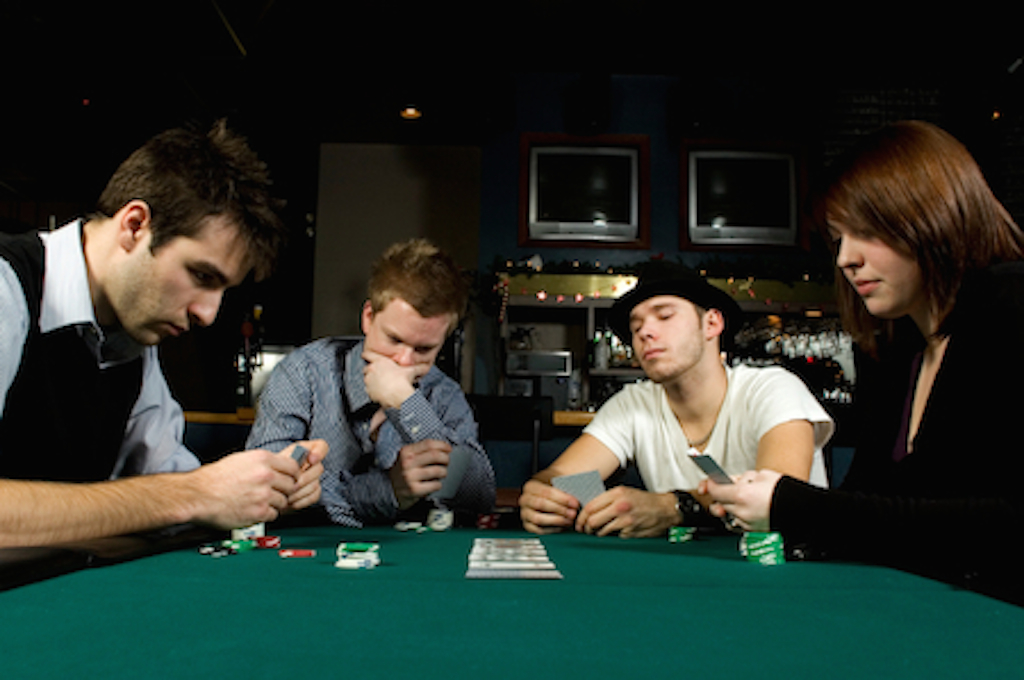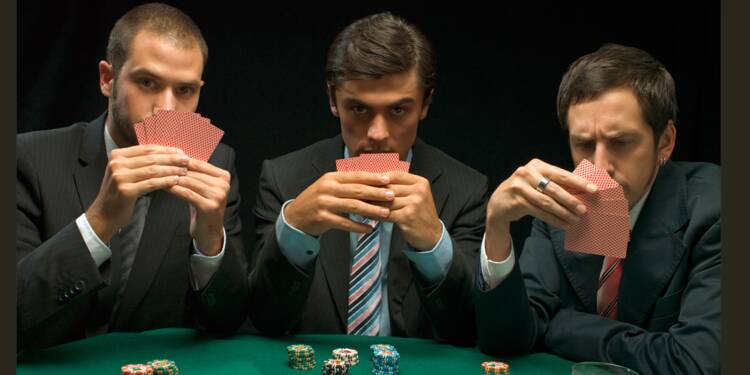Bluffer Poker
This way, the bluffer can distance himself from the act of bluffing and tries to trick his opponent in the process. But let’s not get ahead of ourselves; just because you noticed someone at the poker table using more ‘he’ and ‘she’ than ‘I’ and ‘we,’ this doesn’t mean he’s actually bluffing. Bluffing is life in poker, but not all players feel the same about it. Some players think very conservatively about bluffing. From their point of view, opponents who bluff are taking unnecessary risks. Re: Poker & Bluffer Originally Posted by Aremaz95 When you are playing at a table of 9 players as you discover the bluffers, realize some ruse or just get carried away by luck? I would call it. Mar 05, 2009 In order to successfully bluff in poker, you need to figure out what bluffs will work on what types of players. A good poker player knows the difference, but a bad poker player doesn’t care. Good players know that people can be bluffed while cards can’t. That’s why a show-down is a bluffer’s worst enemy.
We have created an entire line of poker card guards to fit every player. If you've been looking and looking for the perfect card guard to fit you, look no further. We've made it. Whatever your favorite pocket pair is, you can find it in our 'Wired' collection. No matter which hand is yours, we have it. We also have a variety of other starting hands. Starting with the 7 2 off suit, All In coin and continuing with 'I Love Jack King Off', the 'River Rat' coin, The 'K9' coin, 'But They Were Suited!', the 'Nobody Cares What You Folded', and the 'One Time!' coin. Check out our pictures to see the outstanding graphic design of our coins. We will be adding new designs to our collection regularly.
These are currently being collected all over the world. The coins are regularly being bought as a set as giveaways at poker tournaments. The first person to win a hand with a particular pocket pair wins that coin. This has been a huge success for many of our customers and has made their game the best in town. They make great gifts and they have great profit potential for resellers.
Let’s talk about bluffing. It’s the one part of poker strategy that even non-poker players think they understand. Bluffing is, simply put, an act of deception – meant to make your weak hand look stronger than it is – with the intent of getting your opponent to fold.
What makes a bluff successful? You have to know how to pick your spots. There are six general matters you need to consider when deciding whether or not to bluff: your opponents, your image, the betting history of the hand, your position, the strength of your hand, and the size of the bet. Let me address them each in turn.
Your Opponents
Ultimately, your opponents determine whether a bluff will be successful. If you bet and he folds – your bluff works and you win the hand. If you bet and he calls your bluff fails.

So how can you control what your opponent does? You bet your hand; he bets his. What can you do to affect his behavior?

There are many different types of poker players and you need to pick the right opponents to bluff against. Ideally you want to have only one opponent to bluff against. While there are times when your bluff will work against an entire lineup, most of the time you want it to be head to head. Similarly, you want to avoid bad targets for your bluff. You don’t want to bluff a guy who is so bad that he doesn’t think about your bet when he decides to call or fold? You don’t want to try to bluff a guy who is too loose to lay down his hand to your bet – even if he thinks you have him beat. After all, if he’s too bad to think about what your bet means – then he’s too dumb to lay down his hand no matter what you do. So don’t bluff a guy who calls too much. As the saying goes, it’s easier to bluff a good player than a bad player.
Along those lines, the recent history of your opponent needs to be taken into consideration as well. Some players get hammered so badly in a session that they tilt and become fatalistic. They’ll give away the rest of their stack with any kind of draw. They don’t make good targets of your bluff – even if normally they’re a good player. Conversely, if a guy has just won a large pot and is stacking his chips – or if he’s getting ready to leave, or is really close to even, — he’s probably thinking more about preserving his stack – and may make a great target for a bluff – even if he’s not normally too swift. So at that point he’d make a good bluffing taret.
Your Image


Your table image plays a large part in whether your bluff will be successful. You need to be aware of what it is in order to exploit it. If you’re seen as a tight player your bets will more likely be believed as representing strength. Your bluffs will be more likely to succeed. On the other hand, if you’re perceived as a wildman – who throws his chips around like a drunken sailor (or even better – if you are perceived as a drunken sailor) – your bluffs will almost surely fail – since you’re likely to be called. Take your image to others into consideration and make your bluffs accordingly.
Betting History of the Hand
Bets are not viewed in a vacuum. They are part of a narrative. Your bet, to succeed against perceptive opponents, needs to fit into that narrative to be believed. Your good opponent is not likely to believe that your bet on the river means you hit your flush if your betting up until that point didn’t indicate that you were on a flush draw.
Conversely, here’s an example of your bluff following a believable “I made the flush on the river” narrative. In a relatively tight $2-5 game, your early position opponent with a deep stack raised pre-flop to $20. You, also with a deep stack, called with . The flop came . Your opponent bet $35 and you called. The turn was the – making the board . Your opponent bet $50 and you called. The river was the . Your opponent checked. You bet $100. That story is the story of a flush draw turning into a flush when the river card hits. Your pre-river action made it look like you actually hit a flush on the river.
Strength of Your Hand
Pure bluffs – when a hand has absolutely no chance of success unless your opponent folds – are less likely to win you money then bluffs that are combined with hands with the possibility of improving as the hand develops. These are generally known as “semi-bluffs”. I think of them as bluffs with a back up plan – a way to win even if they don’t win outright as a bluff.

Here’s an example of a semi-bluff. It’s the flop. You have . The flop is . You bet. On the one hand you have nothing. If your opponent folds you win. It would be a successful bluff if that happened. But even if he calls you have a chance of getting hitting a ten or a heart on the turn or river and winning that way.
As you can see, a bluff with a backup plan, known as a semi-bluff, is better than just a pure bluff. So take that into consideration when pondering whether or not to bluff.
Your Position
Comment Bluffer Poker
The position you are in relative to the remaining player or players in the hand is an important consideration. Generally, you want to see how your opponent reacts to the board before you decide to bluff – making late position more advantageous than early position when bluffing. If he checks you can often presume him to be weak and bet. If you have to bet or check first, you won’t have the advantage of seeing his reaction to the board.
In poker, however, few things are always true. Sometimes, it may be better to bluff from early position. If, for example, you are against a rather sophisticated opponent, who understands that bluffing is generally more likely from late position, you may be more likely to fool him into folding a superior hand by betting in early position.
Bet Size
In no limit it’s important to think about the size of your bet when you are bluffing. Ideally, you will bet the least amount necessary to get your opponent to fold. But what is that amount?
It may seem that the more you bet the more likely your opponent will be to fold. As a practical matter this is rarely true, however. It’s better to think in terms of thresholds beyond which opponents will not call. And you want to get as close to the threshold as you can.
Here are some examples. The pot is $100. The flop has missed you. Your opponent has checked, indicating weakness. As a rule of thumb, knowing nothing else, a bet of 50% of the pot will generally be enough to get an opponent to fold if he hasn’t hit his hand and isn’t on a draw. There’s generally no need to bet more than $50 in this situation to push your opponent off of his hand. Realize, of course, that every situation is different. If you have reason to suspect that your opponent is on some kind of draw, a larger bet, perhaps one the size of the pot, may be necessary to get him to fold. If you know your opponent to be especially tight, an even smaller bet might be sufficient – perhaps as little as $25. Similarly, if your opponent is a calling station, no matter how large you bet you may not induce him to fold – meaning you shouldn’t attempt a bluff at any price.
Here’s another example. It’s the river. The pot is $300. You’ve read your opponent for a flush draw. The river is not suited so no flush is possible. Your opponent checks. If you’ve read your opponent correctly, there’s no way he will call a bet of any size. On the other hand, you have nothing so you can’t risk checking it down. You can safely bet as little as 25% of the pot and expect a fold. Why risk more, in case he has deceived you with a monster? If he comes over the top you can lay down your bluff without having lost more than $75 on the bluff.
See Full List On Wikihow.com
Conclusion
There’s a time and place to succeed with bluffing, which is a complicated matter. Yet novice players often fall into the trap of bluffing far too much. It’s important that you consider all the factors in this lesson to before you attempt to pull off a bluff.
If you’re new to poker and are just starting out then it’s best to avoid the temptation to bluff. By studying the lessons here on Pokerology you’ll learn much more about the concept of bluffing, along with many other successfully poker strategies. When you combine this knowledge with valuable playing experience, the art of bluffing will become second nature.
Related Lessons
By Ashley Adams
Ashley Adams lives in Boston, Massachusetts and has been playing poker for decades. He is the author of two poker books and his specialty is 7-card stud and no-limit hold'em.